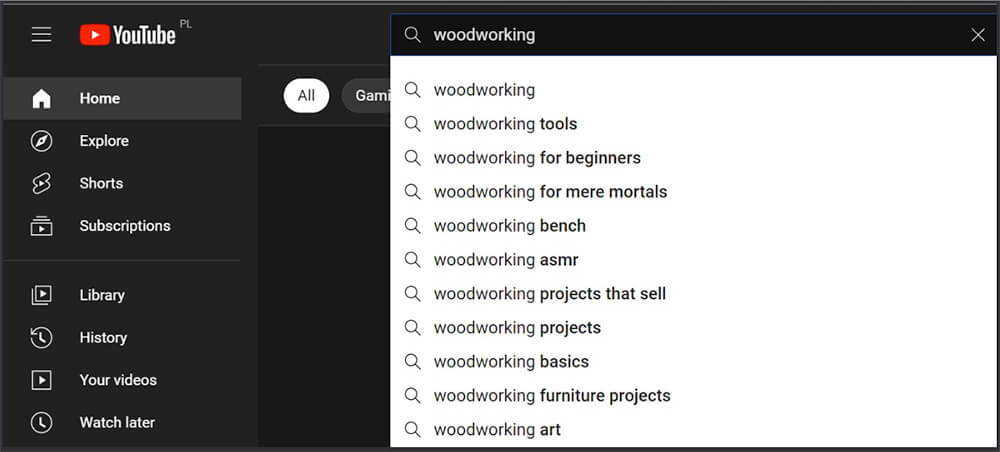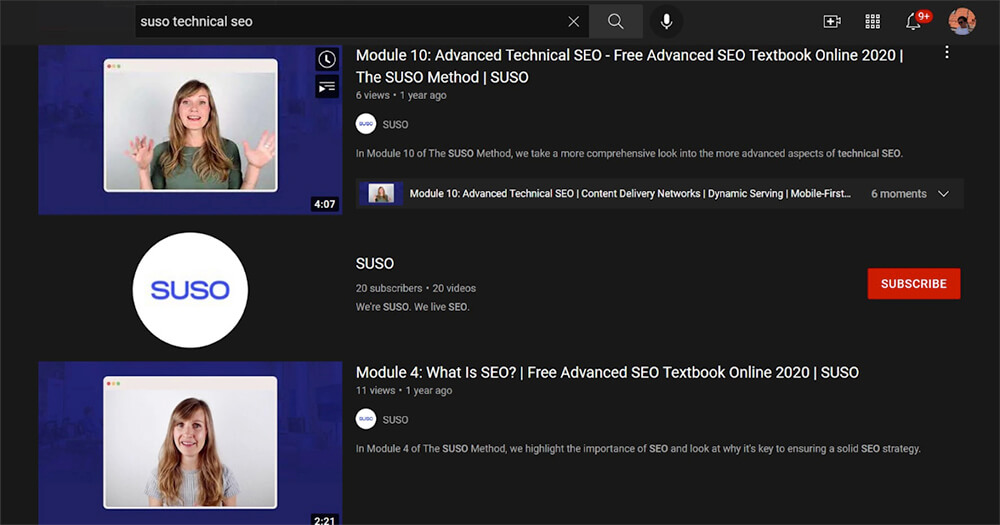YouTube SEO should be a part of any video marketing strategy. Find out how to rank YouTube videos with this guide.
YouTube SEO: How to Rank YouTube Videos
Author: Maciej Grzymkowski, Content Writer

Although they are owned by the same parent company and share quite a few similarities, YouTube and Google operate very differently regarding the way they rank videos and channels. Understanding these differences and how they can affect your videos’ success is paramount to achieving steady growth of views and subscriptions on your YouTube channel.
In this article, we’ll go into great detail about optimising YouTube videos and channel pages to maximise your chances of ranking as high as possible on the YouTube search results page. It is important to note that every YouTube SEO strategy will be different depending on the specificities of the different YouTube channels, their target audiences, and finally, the overarching purpose of the channel itself. The basics of YouTube SEO, however, are pretty much the same across the board, and knowing these fundamentals can go a long way when it comes to improving your YouTube rankings.
Understanding YouTube
The first and most important thing to understand about YouTube as a website is that it is not solely a video-hosting site anymore. It has outgrown its initial premise and become one of the most frequently visited social media sites, as well as the world’s second-largest search engine. On average, about 3 billion searches are made on the platform every month. Thinking of YouTube as just another search engine can be helpful in crafting a cohesive YouTube content marketing strategy and help you put your SEO skills to good use on this platform.
The YouTube SEO process is quite similar to what you would be doing to improve a website’s rank on Google, at least in the very beginning. The content planning phase is primarily based on keyword research and coming up with engaging content ideas that suit the most popular keywords in your niche, which is pretty much what you’d do when planning out content for a regular search engine optimisation strategy.
Things get a little trickier once we move on to the execution part of the entire process. As opposed to writing a blog post or optimising the text on home and landing pages, creating videos for YouTube is a much more complicated procedure, especially if you want to check all of the boxes that will help you rank better.
Where to Get Keyword Ideas
The best way to obtain keyword ideas for your future YouTube videos is by using YouTube’s auto-complete function. It works particularly well if you’re trying to find some long-tail keywords. All you’ve got to do is type in a word or two that are related to your niche, and the autocomplete function will do the rest of the work for you, showing what kind of queries are popular in combination with the word you have typed in. It’s a quick and effective way of finding ideas for new, well-optimised videos.
The image below is a good example of obtaining keyword ideas within the woodworking niche. You can repeat this process with a variety of different keywords and concepts related to your area of expertise until you get enough ideas to create a content plan.

Another good way to get more keyword ideas without using any advanced SEO tools is by simply using Google. Look up a relevant concept within your niche and head over to the “people also ask” section. After unravelling a few of the questions, you’ll notice that some of the answers are taken from YouTube videos. See whether or not these videos cover subjects that you haven’t gone over on your channel and take note of their titles. This type of research is a good way to come up with ideas for evergreen YouTube videos, i.e. videos that do not lose relevance over time and are usually accessed by people through organic search.
When in doubt about the keywords you should be using, make use of free tools such as answerthepublic.com. It is a great website that will automatically provide you with a number of queries based on the brand, idea, or concept that you type in on the home page.
Optimise Your YouTube Channel Page
Think about your YouTube channel page as your business card or the homepage of your website. It should provide some basic information about what kinds of topics you cover on your channel and a bit of background information about yourself. It is important to optimise it, as channel pages can pop up in YouTube search results alongside videos. Secondly, they can go a long way in establishing your trustworthiness and expertise on the subject matter you cover in your videos on a regular basis. Just these two factors alone can help you increase your subscriber count and the number of views you get on your videos.

Aesthetics Matter
It is important for your channel page to look professional and relevant to your subject matter. Channels without cover photos or poorly organised uploads do not tend to encourage viewers to come back to them on a regular basis, and they are definitely not helpful in getting them to hit that coveted “subscribe” button.
You should decide on a cohesive colour palette for your channel and stick to it as you continue to put out more content. This means that you should also be mindful of your thumbnail images. Keep consistent with the colours and style of images that you use. You want your thumbnail to stick out in the “suggested” tab in order for viewers to reach your content when watching other videos, but your own channel page should have a unified colour scheme and be easy on the eye.
The “About” Section
Take some time to think about your “about” section. You might think that not a lot of YouTube users pay much attention to it, but you’d be surprised how many people actually head over there to learn more about a channel that caught their attention. Be sure to include any and all relevant information that could be of use to your target audience and may be the final straw that convinces them to become a subscriber.
The “about” section is also a great opportunity to sneak in quite a few keywords that can help you rank higher in the YouTube search results. This bit of copy about yourself and your videos is the perfect place for the organic inclusion of keywords — after all, this text is all about your channel and what kind of subjects you’re going to be covering. For example, BT Sport’s YouTube channel’s description includes keywords like “Premier League,” “best bits and highlights” or “European Football” without it feeling forced or artificial. While it is definitely important to have keywords in your “about” section, be careful not to go overboard with that. Much like Google, YouTube also punishes keyword stuffing and other bad SEO practices.

Finally, consider the length of your channel’s description. A single paragraph consisting of two or three sentences may not be enough to organically include all of your desired keywords, and will not go into enough detail about your content. On the other hand, be careful not to end up writing a long description that will likely be overlooked just because you’re focused on covering every single aspect of your channel while adding as many keywords as possible. A two-paragraph description that outlines some of your background, as well as the main ideas and purpose of your channel should be sufficient.
Playlists Can Help Your Videos’ Rank
Once you have a decent amount of videos uploaded to your channel, you should consider creating topically organised playlists to help viewers navigate your content and find sequences of videos that will best suit what they are looking for at any particular moment.
Seeing as playlists automatically play any video that is next on the list, it is a great way to rake in hundreds, if not thousands of extra views.
Of course, merely creating a playlist or two is not going to work if the videos you include in them do not have similar themes or don’t cover the same areas of interest. This is why you should incorporate strategic thinking from the very first upload you make on your channel.
Think of organising your playlist as if you were organising the site structure of your website. Instead of creating clusters of topically related web pages, you’re grouping topically related videos.
Optimise Your Video
Now that you know how to optimise your channel page for YouTube SEO, let’s move on to the bread and butter of any YouTuber’s job: the videos. Optimising your videos is an important aspect of getting them to rank better in search results, getting more views, and increasing your subscriber count. YouTube video content is a bit trickier to optimise than blog posts and pages on a website, but it is not an impossible job once you break it down into smaller, more digestible parts.
Keywords in Titles
Earlier on in this article, we provided you with some tips on how to carry out some basic YouTube keyword research. This is where you should put that knowledge to good use. Think of your video title as the equivalent of an H1 (heading 1) of a web page or blog post. Your main target keyword should find its way onto the title in order for your video to be shown on the search results page for it. It’s as simple as that. Of course, merely putting that keyword in the title is not all that there is to it, but it is a necessary start.
When including keywords in the titles of your YouTube videos, make sure to do it in an organic, inconspicuous way. It needs to be grammatically correct, and make sense in the context of the content of your video.
Video Description
While your main target keyword should be included in the title, it can be helpful for your YouTube video optimisation to sneak in other relevant keywords into your title description and tags. This will increase the likelihood of your video ranking for those additional keywords, as well as showing up in the “suggested videos” tab on the right-hand side of other YouTube videos.
Once again, make sure that your description is grammatically sound, and does not make it blatantly obvious that it’s being utilised for SEO purposes. Try to make it useful for the viewers, and include relevant information or details about your video while using as many keywords as possible.
Finally, if you are referring to or directly using footage from another YouTuber in your video, you should include a link to the original content in your description. Aside from being a sign of courtesy towards your fellow creators, it is an important part of a YouTube link-building strategy. When other YouTubers see you giving them a shout-out and referring your own viewers to their channel, they might return the favour and link back to your channel in one of their future videos.
Here’s an example of a poorly optimised description:

And here’s an example of a well optimised video description:

The Importance of the Comment Section
Having a lot of comments under your video is another thing that can help your video rank better in YouTube’s search results. While there is not a lot you can manually do to increase the number of comments, you can encourage your subscribers and viewers to comment by leaving them a reminder to do so at the end of the video. Improve the engagement with your viewer base, and you’ll notice improvements to your YouTube SEO relatively quickly.
In order to direct your user engagement to further your SEO efforts, ask them questions in a way that will prompt them to answer using one of your target keywords. This is a classic case of killing two birds with one stone: on the one hand, you have the increase in engagement, and on the other, the organic use of keywords throughout your comment section. For example, if you have set up a YouTube channel for your woodworking business, you might ask your viewers to leave comments stating what tools they use most frequently in their workshops or to leave requests for other topics to cover in your future videos.
High Retention Videos Are King
The highest-ranking YouTube videos are ones that manage to keep the viewers watching throughout the entirety (or at least the majority) of the video’s duration. Making high retention videos is probably one of the most important ways to get the YouTube algorithm to recommend your content to new viewers and get it to pop up at the top of the search results page for your target keyword.
Nowadays, people get distracted quite easily, which results in most YouTube videos longer than 10 minutes being closed before they are over. Creating high retention content is not the easiest feat, but there are ways to simplify the process. Follow these tips to increase the chances of your videos being watched all the way through.
- Keep it under 10 minutes. In recent years, short-form videos have become the most widely viewed content format, and it doesn’t seem like that is going to change anytime soon. Be concise in your narrative and get your point across without going on too many tangents, and your viewers will be more likely to watch your video from start to finish.
- Make your content “listenable”. If you believe that you won’t be able to convey everything you want to in 10 minutes, make sure to focus on making the video enjoyable without having to stay glued to the screen. People love listening to podcasts, despite them being rather lengthy. Creating your videos in a way that allows viewers to listen to them while doing something else will increase your retention. This is partially why video essays with hours of runtime perform so well on YouTube.
- Outline the structure in your intro. Have a brief summary of what you will talk about in your video in the introduction sequence. This will prompt viewers to stick around to get to the parts that are most interesting to them. Worst case scenario, they’ll just skip to the parts they want to see, but still engage in your content in a more meaningful way.
Quick YouTube SEO Tips
Rename Your Video File
The title of your video on YouTube is one thing, but you should also make it a point to include your target keyword in the actual file name, as well (the .mp4, .avi, or .mov file you upload to the site). Users never see this name, but YouTube’s crawlers do, and it may have an effect on your videos’ ranking.
Add Subtitles and Closed Captions in Different Languages
Translating your videos to different languages and adding subtitles is a surefire way to increase your subscriber base. Not only does it enable thousands of people to consume and enjoy your content, but it is also a sign of a professional, carefully crafted video, which is something that YouTube values above all else.
Use YouTube Cards and End Screens
These cards and end screens are features you can add at the end of your video. They can be links to some other content of yours you might want to promote or an external link to your merchandise store. It is an additional way for people to interact with your video and a vital aspect of any YouTube marketing strategy. Think of it as internal links you would normally see in a blog post, but in a video format.
Final Thoughts
There are plenty of ways to increase the likelihood of your content showing up in the top video results on YouTube. Optimise your videos every time you upload them and turn this practice into a habit. YouTube SEO work is not as complex as Google SEO, but it still requires you to put in some effort.
We recommend that you use keyword research tools normally used for regular SEO, such as Ahrefs’s Keyword Explorer or Answer the Public to identify popular keywords for SEO-friendly video ideas. Utilise video descriptions to your advantage when it comes to organically including the target keyword in your video.
All of the technicalities we’ve gone over in this article can help your content climb the search results pages, but remember: even the best SEO practices won’t help you fool the search algorithm if you don’t put enough effort into making engaging content. Work on your audience engagement to have a vibrant comment section, but above all, stay focused and consistent in making great videos!
More articles
View more of our research.

Constructing An eCommerce Website for SEO
Find out how to construct an eCommerce website that is great for users and accessible for search engines.

Educating Clients on the Value of SEO: A Guide for Marketing Managers
Find out how marketing professionals can transform their clients' perception of SEO by educating them about the value that it can bring to their businesses.
